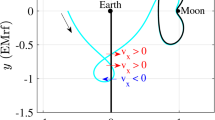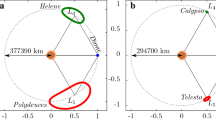Abstract
A symplectic mapping is constructed for the study of the dynamical evolution of Edgeworth-Kuiper belt objects near the 2:3 mean motion resonance with Neptune. The mapping is six-dimensional and is a good model for the Poincaré map of the ‘real’ system, that is, the spatial elliptic restricted three-body problem at the 2:3 resonance, with the Sun and Neptune as primaries. The mapping model is based on the averaged Hamiltonian, corrected by a semianalytic method so that it has the basic topological properties of the phase space of the real system both qualitatively and quantitatively. We start with two dimensional motion and then we extend it to three dimensions. Both chaotic and regular motion is observed, depending on the objects' initial inclination and phase. For zero inclination, objects that are phase-protected from close encounters with Neptune show ordered motion even at eccentricities as large as 0.4 and despite being Neptune-crossers. On the other hand, not-phase-protected objects with eccentricities greater than 0.15 follow chaotic motion that leads to sudden jumps in their eccentricity and are removed from the 2:3 resonance, thus becoming short period comets. As inclination increases, chaotic motion becomes more widespread, but phase-protection still exists and, as a result, stable motion appears for eccentricities up to e = 0.3 and inclinations as high as i = 15°, a region where plutinos exist.
Similar content being viewed by others
References
Duncan, M. J., Levison, H. F. and Budd, S. M.: 1995, ‘The dynamical structure of the Kuiper Belt’, Astron. J. 110(6), 3073–3081.
Gallardo, T. and Ferraz-Mello, S.: 1998, ‘Dynamics in the exterior 2:3 resonance with Neptune’, Planet. Space Sci. 46, 945–965.
Hadjidemetriou, J. D.: 1991, ‘Mapping Models for Hamiltonian Systems with application to Resonant Asteroid Motion’, In: A.E. Roy (ed.), Predictability, Stability and Chaos in N-Body Dynamical Systems, Kluwer Academic Publishers, pp. 157–175.
Hadjidemetriou, J. D.: 1993, ‘Asteroid motion near the 3:1 resonance’, Celest. Mech. & Dyn. Astr. 56, 563–599.
Holman, M. J. and Wisdom, J.: 1993, ‘Dynamical stability in the outer solar system and the delivery of short period comets’, Astron. J. 105(5), 1987–1999.
Jewitt, D., Luu, J. X. and Trujillo, C.: 1998, ‘Large Kuiper belt objects: The Mauna Kea 8K CCD survey’, Astron. J. 115, 2125–2135.
Jewitt, D.: 1999, ‘Kuiper belt objects’, Annu. Rev. Planet. Sci. 27, 287–312.
Jewitt, D. and Luu, J. X.: 2000, In: Vince Mannings (ed.), Physical Nature of the Kuiper Belt. Protostars and Planets IV, Univ. Az. Press, pp. 1201–1229.
Knezevic, Z., Milani, A., Farinella, P., Froechlé, Ch. and Froechlé, C.: 1991, Secular resonances from 2 to 50 AU, Icarus 93, 316–330.
Kotoulas, Th. and Hadjidemetriou, J.: 2002, ‘Periodic orbits of trans-Neptunian objects at the 2/3 and 3/4 resonances’, Proceedings of the CELMEC III meeting, Roma 2001 (accepted).
Levison, H. F. and Stern, A.: 1995, ‘Possible origin and early dynamical evolution of the Pluto-Charon binary’, Icarus 116, 315–339.
Malhotra, R.: 1996, ‘The Phase Space structure near Neptune resonances in the Kuiper belt’, Astron. J. 111 (1), 504–516.
Maran, M. D. and Williams, I. P.: 2000, ‘The evolution of bodies orbiting in the trans-Neptunian region on to intermediate-type orbits’, Mon. Not. R. Astron. Soc. 318, 482–492.
Morbidelli, A.: 1997, Chaotic diffusion and the origin of comets from the 2/3 resonance in the Kuiper Belt’, Icarus 127, 1–12.
Morbidelli, A.: 1999, ‘An overview on the Kuiper belt and on the origin of jupiter-family comets’, Celest. Mech. & Dyn. Astr. 72, 129–156.
Morbidelli, A., Thomas, F. and Moons, M.: 1995, ‘The resonant structure of the Kuiper belt and the dynamics of the first five trans-Neptunian objects’, Icarus 118, 322340.
Nesvorný, D. and Roig, F.: 2000, ‘Mean motion resonances in the trans-Neptunian region. I. The 2:3 resonance with Neptune, Icarus 48, 282–300.
Roig, F. and Ferraz-Mello, S.: 1999, ‘A symplectic mapping approach of the dynamics of the Hecuba gap’, Planet. Space Sci. 47, 653–664.
Šidlichovský, M.: 1996, Private communication.
Wisdom, J.: 1983, ‘Chaotic behaviour and the origin of the 3/1 Kirkwood gap’, Icarus 56, 51–74.
Wisdom, J.: 1985, ‘A perturbative treatment of motion near the 3/1 commensurability’, Icarus 63, 272–289.
Wisdom, J. and Holman, M.: 1991, ‘Symplectic maps for the n-body problem’, Astron. J. 102 (4), 1528–1538.
Yu, Q. and Tremaine, S.: 1999, ‘The dynamics of Plutinos’, Astron. J. 118, 1873–1881.
Author information
Authors and Affiliations
Rights and permissions
About this article
Cite this article
Hadjifotinou, K.G., Hadjidemetriou, J.D. A Symplectic Mapping Model for the Study of 2:3 Resonant Trans-Neptunian Motion. Celestial Mechanics and Dynamical Astronomy 84, 135–157 (2002). https://doi.org/10.1023/A:1019972710162
Issue Date:
DOI: https://doi.org/10.1023/A:1019972710162




